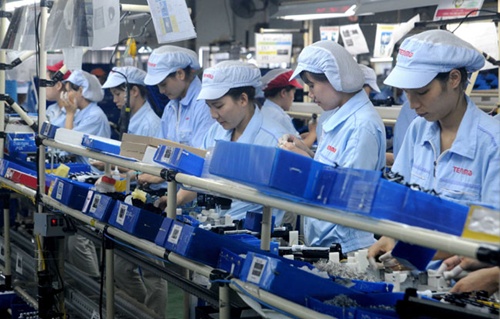FDI expected to surge in 2015
FDI expected to surge in 2015
Foreign direct investment (FDI) in Viet Nam is forecast to increase significantly this year, as many large FDI projects are expected to be issued licences in the next few months.

The Thoi bao Kinh te Viet Nam (Vietnam Economic Times) newspaper quoted a source from the Economic Zone Management Authority (EZMA) of Binh Dinh as saying that the central province is scrutinising the Nhon Hoi oil refinery complex (also known as Victory Project). The project is expected to be issued an investment licence before the Lunar New Year (falling on February 19).
If the licence is issued as per EZMA's plan, the FDI capital in Binh Dinh this year will far exceed the capital that the province attracted last year, as the investment capital of the Nhon Hoi project alone is estimated at US$22 billion.
Also, Nhon Hoi is not the unique large FDI project that Binh Dinh can attract this year.
Head of Binh Dinh's EZMA Man Ngoc Ly said that the province is also working with two other large investors, Singapore's VSIP and Thailand's Amata, to select sites for the projects' infrastructure construction.
If their progress is advantageous, the two projects are likely to help Binh Dinh figure among the country's most attractive FDI destinations in 2015.
Besides Binh Dinh, the northern province of Bac Ninh is also expected to issue licences to large FDI projects this month.
Ngo Sy Bich, head of Bac Ninh's EZMA, said that the projects that can be issued licences early this year in the province are also large, with each having hundreds of millions of dollars of investment capital.
He revealed that Bac Ninh is working with a Singapore-based software investor and, if it works out, a project worth more than $100 million will be issued a licence this month.
Bac Ninh is also negotiating with a German investor. If the deal is signed, hundreds of millions of dollars will be poured into the province. It is expected that the project will also help the northern province to attract other FDI supporting projects.
Experts said that licensed projects worth billions of dollars have so far helped Viet Nam to attract many other supporting projects. This is in accordance with the Government's sustainable growth strategy involving investment boost to high-tech industries and creation of value-added exports and supporting industries.
Bac Ninh, for example, has so far successfully attracted several large high-tech companies such as Canon and Sumitomo of Japan, Samsung of South Korea, Foxconn and Mictac of Taiwan, and Tyco Electronics and Nokia of the United States, besides ABB of Switzerland.
The northern port city of Hai Phong has also created a hub to attract heavy industry projects worth hundreds millions of dollars of GE, Kyocera, Bridgestone and Fuji, as well as Xerox and Toyota.
Experts have also forecast that Viet Nam will possibly attract increased FDI capital in 2015 as a result of the advantages offered by the free-trade agreements (FTAs) that were concluded in 2014.
Vo Tri Thanh, deputy director of the Central Institute for Economic Management, said that the signing of three FTAs with the European Union, the Republic of Korea and the Customs Union of Russia, Belarus and Kazakhstan will offer great advantages to Viet Nam in attracting foreign investment in the short run.
After Viet Nam concluded the three above-mentioned FTAs, and as a result of the Chinese Investment Strategy +1, businesses in the European Union and the Republic of Korea may shift their production facilities from China, and Viet Nam will certainly be an attractive destination, Thanh said. He added that following their example, a number of supply businesses will invest in Viet Nam.
After the ASEAN Economic Community (AEC) is established in 2015, investors from countries which have concluded FTAs with Viet Nam will see ASEAN as a common market and a united production facility in the near future. As an ASEAN member with accelerated trade liberalisation, Viet Nam will become an important gateway for foreign investors, including European Union companies, to enter the ASEAN market.
Statistics from the Ministry of Planning and Investment's Foreign Investment Agency showed that Viet Nam attracted $20.23 billion in FDI capital last year, an increase of 19 per cent against the target. The Republic of Korea led the 60 countries and territories investing in Viet Nam in 2014, with $7.32 billion in investment capital, accounting for 36.2 per cent of the country's total FDI capital.



















